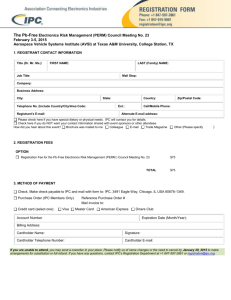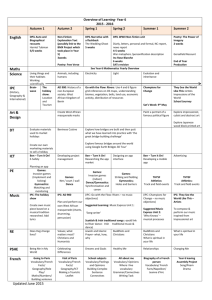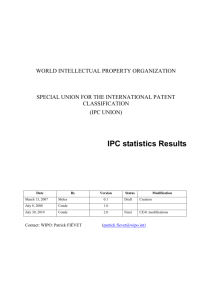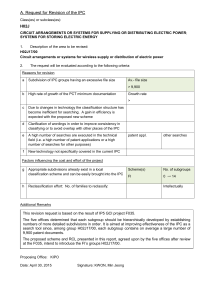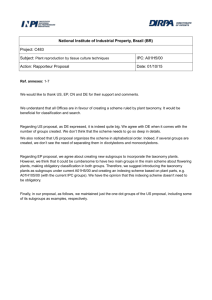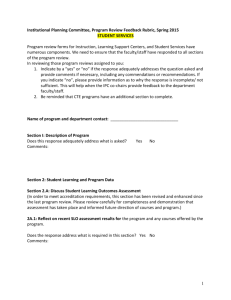IPC/WG/12/4: Report (annex g)
advertisement
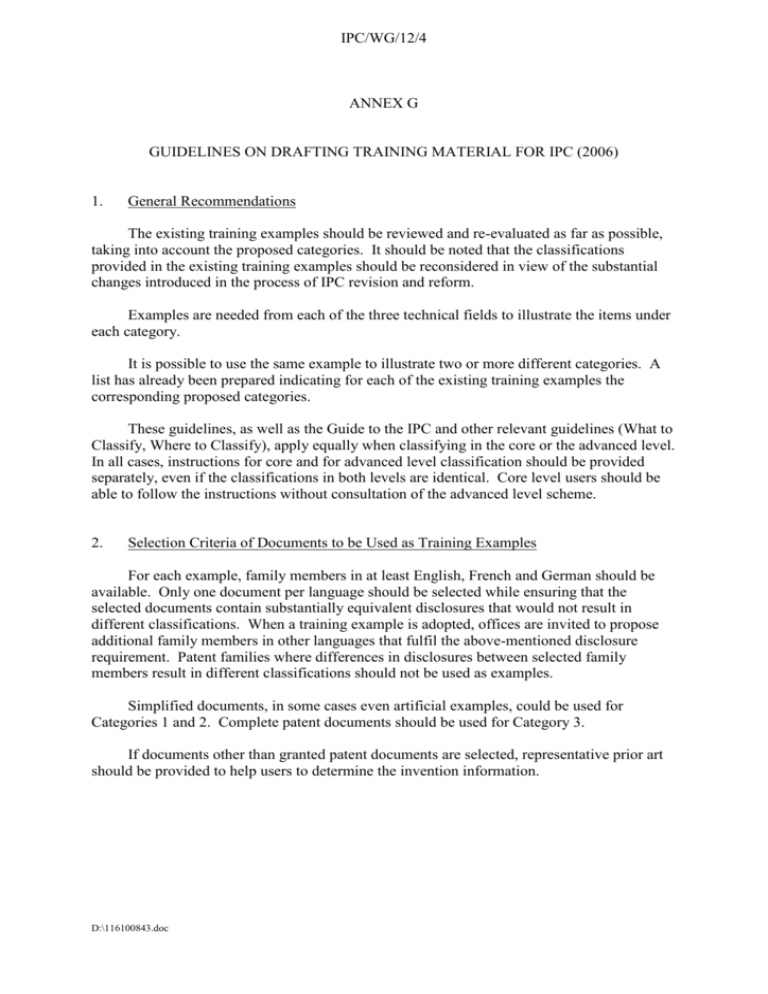
IPC/WG/12/4 ANNEX G GUIDELINES ON DRAFTING TRAINING MATERIAL FOR IPC (2006) 1. General Recommendations The existing training examples should be reviewed and re-evaluated as far as possible, taking into account the proposed categories. It should be noted that the classifications provided in the existing training examples should be reconsidered in view of the substantial changes introduced in the process of IPC revision and reform. Examples are needed from each of the three technical fields to illustrate the items under each category. It is possible to use the same example to illustrate two or more different categories. A list has already been prepared indicating for each of the existing training examples the corresponding proposed categories. These guidelines, as well as the Guide to the IPC and other relevant guidelines (What to Classify, Where to Classify), apply equally when classifying in the core or the advanced level. In all cases, instructions for core and for advanced level classification should be provided separately, even if the classifications in both levels are identical. Core level users should be able to follow the instructions without consultation of the advanced level scheme. 2. Selection Criteria of Documents to be Used as Training Examples For each example, family members in at least English, French and German should be available. Only one document per language should be selected while ensuring that the selected documents contain substantially equivalent disclosures that would not result in different classifications. When a training example is adopted, offices are invited to propose additional family members in other languages that fulfil the above-mentioned disclosure requirement. Patent families where differences in disclosures between selected family members result in different classifications should not be used as examples. Simplified documents, in some cases even artificial examples, could be used for Categories 1 and 2. Complete patent documents should be used for Category 3. If documents other than granted patent documents are selected, representative prior art should be provided to help users to determine the invention information. D:\116100843.doc IPC/WG/12/4 Annex G, page 2 3. Drafting of Training Material Each training example is composed of two parts, the training material and the patent documents. In case of artificial examples only the training material will be available. In general, the training material for each example should contain the following parts: categories; relevant bibliographic data for the selected family members; a short, simplified version of the disclosure (improved abstract) or the text of an artificial example, with a drawing or chemical formula where appropriate; representative prior art (only for examples of Category 3); invention information; any additional information (only for examples of Category 3); explanations on where to classify the invention information and any additional information according to the IPC; complete classification in the core and advanced levels. The International Bureau will provide the patent documents of the existing training examples in text files. In some cases simplified documents should be prepared by the rapporteur containing only parts of the description and those claims which are necessary for the classification of the document. For the examples of Categories 1 and 2, invention information should be explicitly stated and the relevant places in patent documents should be highlighted. For examples of Category 3 relating to documents other than granted patents, representative examples of prior art should be given. The prior art should be presented by: (i) pointing to the relevant passages of the disclosure which illustrate the prior art known to the applicant, or (ii) pointing to a document available together with the disclosure, e.g., a document cited in a search report. A detailed explanation should be provided on how to determine the invention information in the context of the prior art, using guidance provided by the claims, the description and the drawings. Where Category 3 examples relate to granted patents, the prior art and the invention information are assumed to be reflected in the granted claims. IPC/WG/12/4 Annex G, page 3 For all categories, links from the training material to the corresponding part of the document should be indicated, where possible. For all examples, explanation should be provided on how to identify potential subclasses (e.g., using IPC categorizer, Catchword Index, etc.) and how to select the relevant subclass(es). For each relevant subclass that has been identified, the relevant main group(s) and then subgroup(s) should be selected using IPC rules, notes etc. Separate full explanations for the classifications given should be made for both the core and the advanced levels of the IPC. In the core level explanation, the text should make no reference to the advanced level. If the example illustrates a category which is useful only in the advanced level, this should be indicated at the beginning of the example, next to the category to which it applies. The complete classification should be presented in the format indicated in the Guide to the IPC (Chapter XII). The standard template should be used for drafting training examples. Depending on the category, some fields may not be needed as indicated. 4. Interactive IPC Tutorials It should be noted that the updated and revised IPC training examples will be available on the WIPO IPC website in the form of IPC tutorials that will implement an interactive mode of providing training information by using the available software package. In addition to the first part of the tutorials entitled “Tutorial Description” which contains necessary parts of the claims and the description, cited from the original patent documents, with invention information and additional information (if any) highlighted, the current provisional version of the IPC tutorials includes the following steps: Read the specification Identify invention information Classify the invention information Identify additional information Classify the additional information Final Classification. The IPC tutorials provide the necessary information for classification in an interactive way by raising several questions for each of the above steps, to which the user is requested to answer in the form of multiple choices. The system indicates to the user whether his choice is correct, and can give the correct answer if the user has problems finding it. It is recommended that rapporteurs take account of the content provided in the IPC tutorials when drafting training examples and propose additional information for the IPC tutorials, where necessary. For example, in order to better illustrate a classification rule, rapporteurs should indicate the reasons why alternative classification symbols are inappropriate. These alternatives could then be used for the drafting of the multiple choices. [Annex H follows]

